Launching
To generate the lift needed for flying, a (non-hovering) bird needs to be moving through the air. The problem, then, is how to get up to cruising speed from a standing start. If there is a wind, then taking off into the wind gives the bird an advantage. If there is no wind, but the bird is perched well above the ground, it uses gravity to provide acceleration. If it has none of these advantages, it may have to run across the surface picking up speed as does an airplane.
A bird stays aloft by pushing (using its wings to push) air downward. This downward moving air takes the form of a descending vortex (imagine an invisible smoke ring). One of the problems of instigating flight is to get this vortex started vigourously. This is often done using the clap-fling manoeuvre. Not an option for human-made aircraft, this technique involves causing some air to move rapidly between, and thus across, the upraised wings. As the wings are lowered in the downstroke, this gush of air instigates the vortex.
Birds use a range of tactics to become airborne. The picture below hint at some of them.
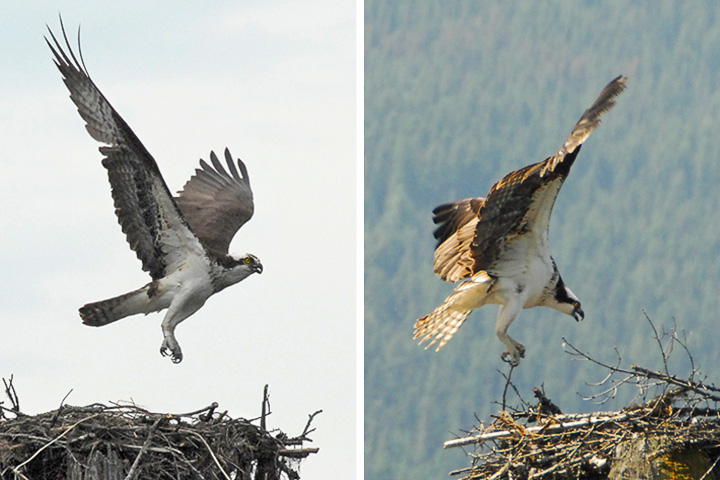 These two images show an Osprey launching from its nest (left), and another landing (right). One can see at least five differences.
These two images show an Osprey launching from its nest (left), and another landing (right). One can see at least five differences.
• Position: the launching bird is approaching the trailing edge of the nest, while the landing one is approaching the leading edge.
• Wings: the launching bird’s wings have a smaller angle of attach than the landing bird’s.
• Tail: it is only spread to increase lift, drag, and directional stability when landing.
• Head: tilted to see ahead; up when launching; down when landing.
• Legs: bent back from having pushed off when launching, but positioned forward to take the weight when landing.
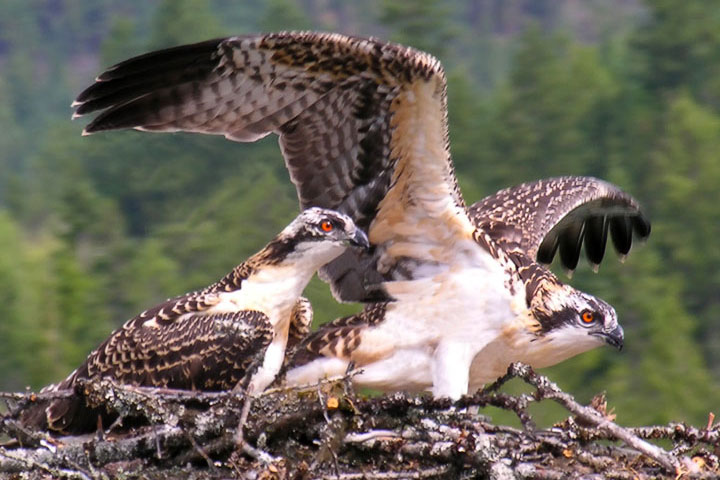 Birds face a problem with flight: how to get up to flight speed when launching? If there is a strong wind, the problem is decreased as the bird only has to face into the wind and spread its wings to become airborne. These are Osprey chicks learning to fly.
Birds face a problem with flight: how to get up to flight speed when launching? If there is a strong wind, the problem is decreased as the bird only has to face into the wind and spread its wings to become airborne. These are Osprey chicks learning to fly.
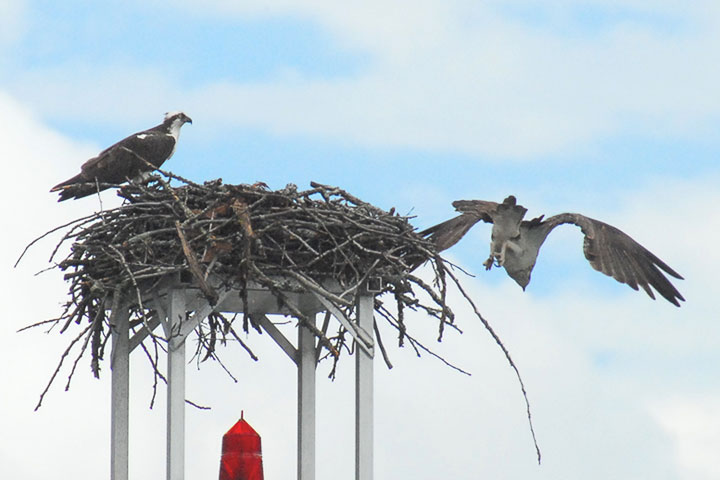 From the smallest song bird to the largest raptor, birds which start from an elevated perch will often use gravity to help them pick up flight speed when they launch into the air—an approach which is especially useful when the wind is light. Here, the wind is calm and the osprey on the right just pushed off its nest atop a dolphin and then picked up speed by descending. In a stronger wind, the osprey will just face the wind and lift off.
From the smallest song bird to the largest raptor, birds which start from an elevated perch will often use gravity to help them pick up flight speed when they launch into the air—an approach which is especially useful when the wind is light. Here, the wind is calm and the osprey on the right just pushed off its nest atop a dolphin and then picked up speed by descending. In a stronger wind, the osprey will just face the wind and lift off.
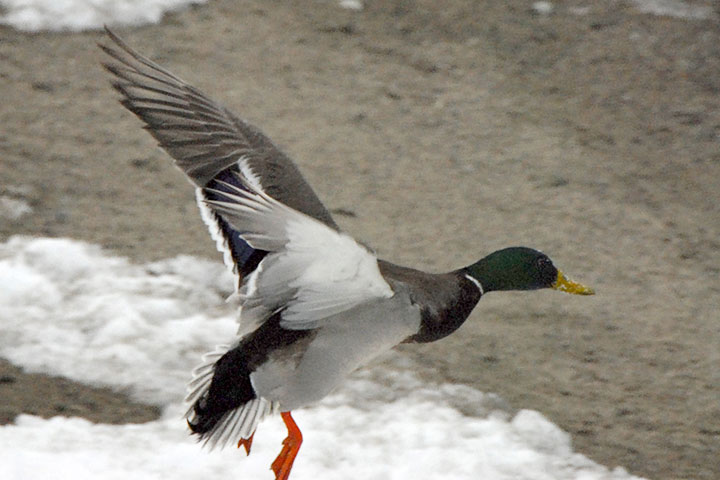 Ducks and other swimming birds don’t usually have the advantage of launching from a perch. Dabbling ducks, such as this Mallard have strong wings and legs and can just jump into the air and start flying.
Ducks and other swimming birds don’t usually have the advantage of launching from a perch. Dabbling ducks, such as this Mallard have strong wings and legs and can just jump into the air and start flying.
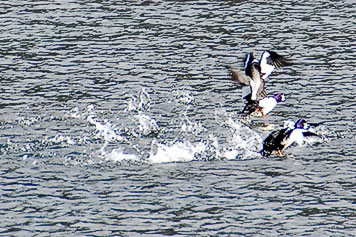 Many diving ducks, such as these Barrow’s Goldeneyes have smaller wings (because they are adapted for swimming underwater) and have to run across the water to pick up enough speed to become airborne.
Many diving ducks, such as these Barrow’s Goldeneyes have smaller wings (because they are adapted for swimming underwater) and have to run across the water to pick up enough speed to become airborne.
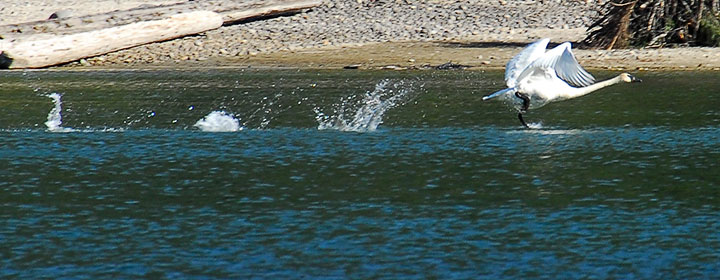 The Trumpeter Swan is the largest water bird on the Lake. To become airborne, it must run across the surface of the the water. Like a cyclist, the trumpeter’s legs are pumping: in the picture, the right foot is up and the left is down pushing against the water. Behind it are the widely spaced foot prints as it picks up speed.
The Trumpeter Swan is the largest water bird on the Lake. To become airborne, it must run across the surface of the the water. Like a cyclist, the trumpeter’s legs are pumping: in the picture, the right foot is up and the left is down pushing against the water. Behind it are the widely spaced foot prints as it picks up speed.
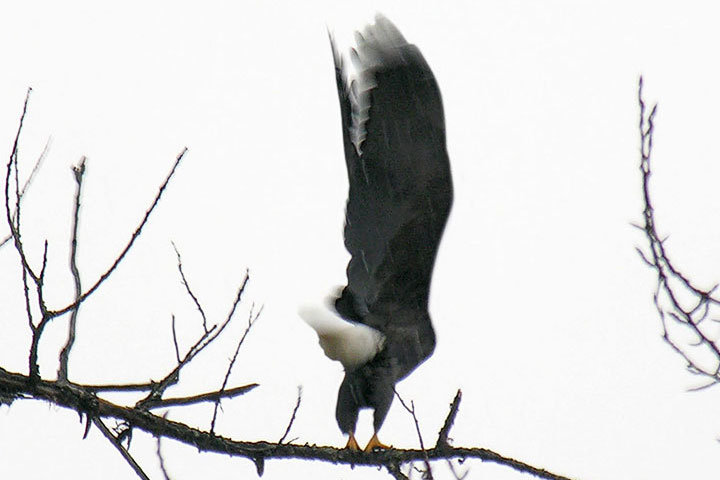 A Bald Eagle raises its wings in preparation for flying. It increases lift during takeoff with the clap-fling manoeuvre: at the beginning of the downstroke the wings are clapped together over the head and then flung open, spreading first at the leading edge to form a V. The air which rushes into the gap instigates the wake vortex earlier than it would have with a simple downstroke.
A Bald Eagle raises its wings in preparation for flying. It increases lift during takeoff with the clap-fling manoeuvre: at the beginning of the downstroke the wings are clapped together over the head and then flung open, spreading first at the leading edge to form a V. The air which rushes into the gap instigates the wake vortex earlier than it would have with a simple downstroke.
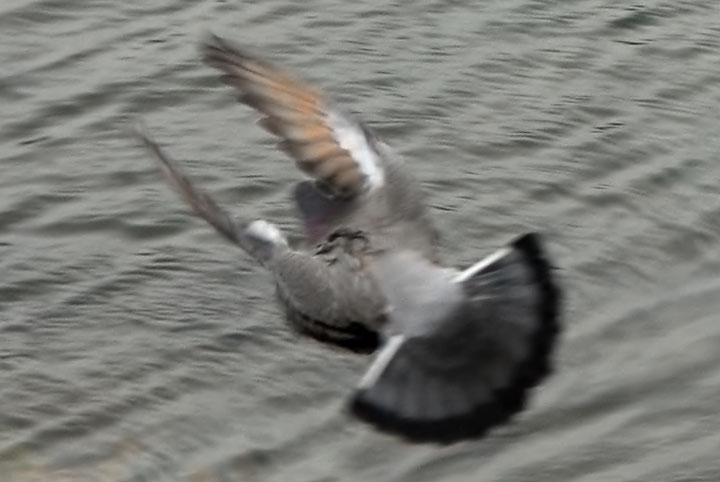 The clap-fling manoeuvre is a frequent tactic of pigeons as they launch themselves into the air. One can often hear their wings slapping together a few times as they get underway.
The clap-fling manoeuvre is a frequent tactic of pigeons as they launch themselves into the air. One can often hear their wings slapping together a few times as they get underway.
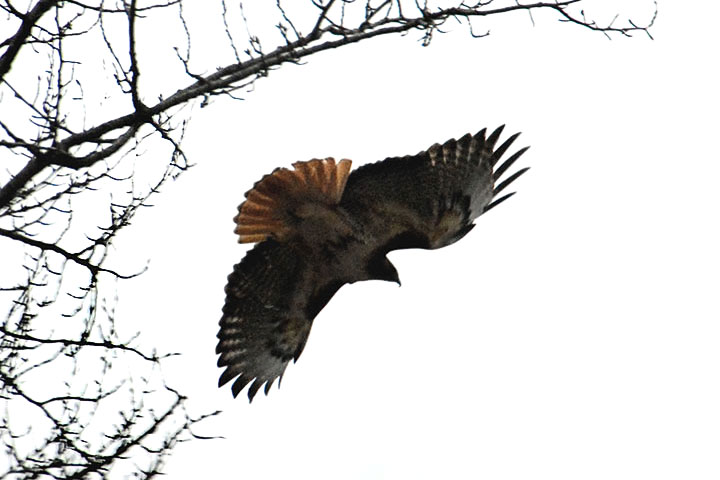 One does not often see a bird deploy its alulae when launching; when seen, they usually appear during a landing. These small extensions near the wrist of the wing apparently increase lift when the wings are near a stall. This Red-tailed Hawk may have used them during this launch from tree because the clutter of branches from which it has just emerged made it too cramped to use the clap-fling manoeuvre.
One does not often see a bird deploy its alulae when launching; when seen, they usually appear during a landing. These small extensions near the wrist of the wing apparently increase lift when the wings are near a stall. This Red-tailed Hawk may have used them during this launch from tree because the clutter of branches from which it has just emerged made it too cramped to use the clap-fling manoeuvre.
![]()